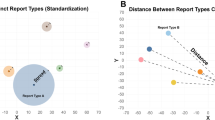The reporting of radiological images is undergoing dramatic changes due to the introduction of two new technologies: structured reporting and speech recognition. Each technology has its own unique advantages. The highly organized content of structured reporting facilitates data mining and billing, whereas speech recognition offers a natural succession from the traditional dictation–transcription process. This article clarifies the distinction between the process and outcome of structured reporting, describes fundamental requirements for any effective structured reporting system, and describes the potential development of a novel, easy-to-use, customizable structured reporting system that incorporates speech recognition. This system should have all the advantages derived from structured reporting, accommodate a wide variety of user needs, and incorporate speech recognition as a natural component and extension of the overall reporting process.

Similar content being viewed by others
References
Reiner BI, Siegel EL, Shrastri K: The future of radiology reporting. In: Reiner BI, Siegel EL, Weiss DL Eds. Electronic Reporting in the Digital Medical Enterprise: Society for Computer Applications in Radiology, Great Falls, 2003, pp 83–104
S Seltzer P Kelly D Adams et al. (1994) ArticleTitleExpediting the turnaround of radiology reports: Use of total quality management to facilitate radiologists' report signing Am J Roentgenol 162 775–781 Occurrence Handle1:STN:280:ByuC1cbjvFI%3D
B Holman P Aliabadi S Silverman et al. (1994) ArticleTitleMedical impact of unedited preliminary radiology reports Radiology 191 519–521 Occurrence Handle1:STN:280:ByuB3cvitlQ%3D Occurrence Handle8153332
J Sobel M Pearson K Gross et al. (1996) ArticleTitleInformation content and clarity of radiologists' reports for chest radiography Acad Radiol 3 709–717 Occurrence Handle10.1016/S1076-6332(96)80407-7 Occurrence Handle1:STN:280:ByiD3sjovVY%3D Occurrence Handle8883510
Digital Imaging and Communications in Medicine Standards Committee. (2000) DICOM Supplement 23: Structured Reporting Storage SOP Classes (proposed final text). National Electrical Manufacturers Association, Rosslyn, VA
Dai BY, Thompson L, Dionisio JDN, Kangarloo H, Taira R, Sinha U: The Next Step.http://www.imagingeconomics.com/library/200004-03.asp
CP Langlotz L Meininger (2000) ArticleTitleEnhancing the expressiveness and usability of structured image reporting systems Proc AMIA Symp 2000 467–471
D Liu GD Berman RN Gray (2003) ArticleTitleThe use of structured radiology reporting at a community hospital: A 4-year case study of more than 200,000 reports Appl Radiol 32 23–26 Occurrence Handle1:CAS:528:DC%2BD3sXksl2gtLs%3D
Digital Imaging and Communications in Medicine Standards Committee. DICOM Supplement 23: Structured Reporting Storage SOP Classes (proposed final text). National Electrical Manufacturers Association, Rosslyn, VA, 2000
Bajai S: Expanding the reach of speech recognition: extending speech technology benefits to transcription workflow can boost productivity—medical practice Health Management Technology. March, 2004.http://www.findarticles.com/p/articles/mi_m0DUD/is_3_25/ai_114167703/
Batchelor JS: Optimizing alternative reporting strategies, 16 July, 2004. http://www.auntminnie.com/index.asp?Sec=sup&Sub=ris&Pag=dis&ItemId=62275
Baumann J: Voice Recognition, 25 Sep. 2004. http://www.hitl.washington.edu/scivw/EVE/I.D.2.d.VoiceRecognition.html>
Author information
Authors and Affiliations
Corresponding author
Appendix: Glossary of Terms
Appendix: Glossary of Terms
- Data Mining:
-
The retrieval of meaningful information and relationships from databases
- DICOM SR:
-
Digital Imaging and Communications in Medicine (DICOM) Structured Reporting (SR); the set of guidelines for the radiology and cardiology imaging industries that specify standards for structuring information about radiological and other images
- Dynamic Menu:
-
A menu that changes when the user presses a modifier key
- Guidepost:
-
A shortcut that takes a user to a menu of macros, knowledge tree selections, or user inputs such as dictation
- Lexicon:
-
The vocabulary of a special language or field
- Macro:
-
A sequence of computer steps that can be recorded so that they can be triggered by one or a small number of keystrokes, mouse clicks, or voice commands
- Macro Behavior:
-
A macro that is an action as opposed to a simple set of words
- Menu Navigation:
-
The process of moving a computer's attention from one part of a list of choices to another or from one list of choices to another
- PACS:
-
Picture archiving and communication systems
- RIS:
-
Radiology information systems
- Structured Reporting:
-
The capturing of standardized/organized information from templates navigated via menus
- Template:
-
Something that is copied. StructuRad's unique use: data elements from which a report is constructed
- Talking Template:
-
A voice-based, interactive template
- Taxonomy:
-
A classification
- Voice recognition software:
-
Software that can translate vocal input into text or commands
- Voice User Interface (VUI):
-
Computer interface that enables users to interact with a computer using speech
Rights and permissions
About this article
Cite this article
Liu, D., Zucherman, M. & Tulloss, W.B. Six Characteristics of Effective Structured Reporting and the Inevitable Integration with Speech Recognition. J Digit Imaging 19, 98–104 (2006). https://doi.org/10.1007/s10278-005-8734-0
Published:
Issue Date:
DOI: https://doi.org/10.1007/s10278-005-8734-0
Key words
- Data mining
- direct reporting
- dynamic menu
- English composition software
- free text
- guidepost
- hierarchical organization
- knowledge base
- lexicon
- macro
- macro reporting
- menu navigation
- radiology reporting
- RadLex
- semantic net
- speech recognition
- structured report
- structured reporting
- talking template
- taxonomy
- template
- speech recognition software
- voice user interface (VUI)




